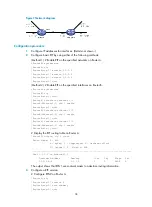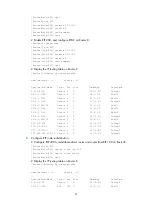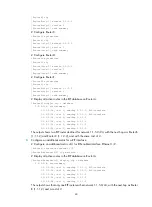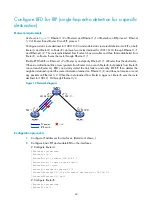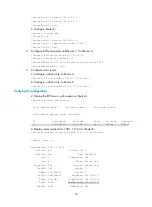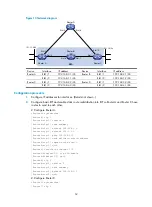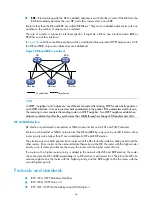
49
Configure BFD for RIP (single-hop echo detection for a specific
destination)
Network requirements
As shown in
, Ethernet 1/2 of Router A and Ethernet 1/1 of Router B run RIP process 1. Ethernet
1/2 of Router B and Router C runs RIP process 1.
Configure a static route destined for 100.1.1.0/24 and enable static route redistribution into RIP on both
Router A and Router C so Router B can learn two routes destined for 100.1.1.0/24 through Ethernet 1/1
and Ethernet 1/2. The route redistributed from Router A has a smaller cost than that redistributed from
Router C, so Router B uses the route through Ethernet 1/1.
Enable BFD for RIP on Ethernet 1/2 of Router A, and specify Ethernet 1/1 of Router B as the destination.
When a unidirectional link occurs (packets from Router A can reach Router B, but packets from Router B
cannot reach Router A), BFD can quickly detect the link failure and notify RIP. RIP then deletes the
neighbor relationship and the route information learned on Ethernet 1/2, and does not receive or send
any packets on Ethernet 1/2. When the route learned from Router A ages out, Router B uses the route
destined for 100.1.1.1 24 through Ethernet 1/2.
Figure 12
Network diagram
Configuration procedure
1.
Configure IP addresses for interfaces. (Details not shown.)
2.
Configure basic RIP and enable BFD on the interfaces:
# Configure Router A.
<RouterA> system-view
[RouterA] rip 1
[RouterA-rip-1] network 192.168.2.0
[RouterA-rip-1] import-route static
[RouterA-rip-1] quit
[RouterA] interface ethernet 1/2
[RouterA-Ethernet1/2] rip bfd enable destination 192.168.2.2
[RouterA-Ethernet1/2] quit
# Configure Router B.
<RouterB> system-view
[RouterB] rip 1




